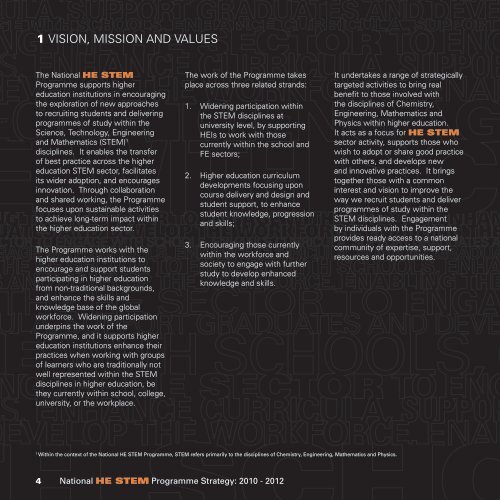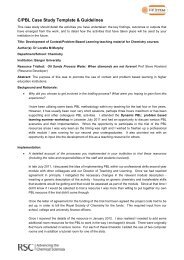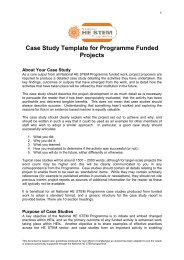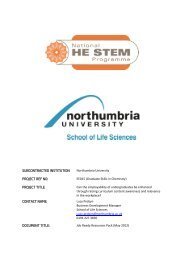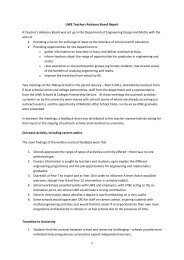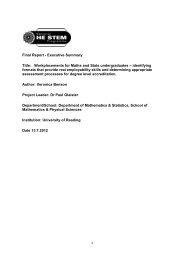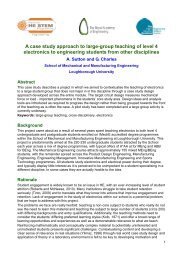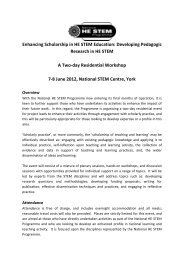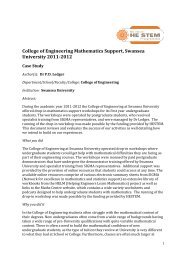STRATEGY 2010 - 12 - National HE STEM Programme
STRATEGY 2010 - 12 - National HE STEM Programme
STRATEGY 2010 - 12 - National HE STEM Programme
Create successful ePaper yourself
Turn your PDF publications into a flip-book with our unique Google optimized e-Paper software.
1 VISION, MISSION AND VALUES<br />
The <strong>National</strong> <strong>HE</strong> <strong>STEM</strong><br />
<strong>Programme</strong> supports higher<br />
education institutions in encouraging<br />
the exploration of new approaches<br />
to recruiting students and delivering<br />
programmes of study within the<br />
Science, Technology, Engineering<br />
and Mathematics (<strong>STEM</strong>) 1<br />
disciplines. It enables the transfer<br />
of best practice across the higher<br />
education <strong>STEM</strong> sector, facilitates<br />
its wider adoption, and encourages<br />
innovation. Through collaboration<br />
and shared working, the <strong>Programme</strong><br />
focuses upon sustainable activities<br />
to achieve long-term impact within<br />
the higher education sector.<br />
The <strong>Programme</strong> works with the<br />
higher education institutions to<br />
encourage and support students<br />
participating in higher education<br />
from non-traditional backgrounds,<br />
and enhance the skills and<br />
knowledge base of the global<br />
workforce. Widening participation<br />
underpins the work of the<br />
<strong>Programme</strong>, and it supports higher<br />
education institutions enhance their<br />
practices when working with groups<br />
of learners who are traditionally not<br />
well represented within the <strong>STEM</strong><br />
disciplines in higher education, be<br />
they currently within school, college,<br />
university, or the workplace.<br />
The work of the <strong>Programme</strong> takes<br />
place across three related strands:<br />
1. Widening participation within<br />
the <strong>STEM</strong> disciplines at<br />
university level, by supporting<br />
<strong>HE</strong>Is to work with those<br />
currently within the school and<br />
FE sectors;<br />
2. Higher education curriculum<br />
developments focusing upon<br />
course delivery and design and<br />
student support, to enhance<br />
student knowledge, progression<br />
and skills;<br />
3. Encouraging those currently<br />
within the workforce and<br />
society to engage with further<br />
study to develop enhanced<br />
knowledge and skills.<br />
It undertakes a range of strategically<br />
targeted activities to bring real<br />
benefit to those involved with<br />
the disciplines of Chemistry,<br />
Engineering, Mathematics and<br />
Physics within higher education.<br />
It acts as a focus for <strong>HE</strong> <strong>STEM</strong><br />
sector activity, supports those who<br />
wish to adopt or share good practice<br />
with others, and develops new<br />
and innovative practices. It brings<br />
together those with a common<br />
interest and vision to improve the<br />
way we recruit students and deliver<br />
programmes of study within the<br />
<strong>STEM</strong> disciplines. Engagement<br />
by individuals with the <strong>Programme</strong><br />
provides ready access to a national<br />
community of expertise, support,<br />
resources and opportunities.<br />
1<br />
Within the context of the <strong>National</strong> <strong>HE</strong> <strong>STEM</strong> <strong>Programme</strong>, <strong>STEM</strong> refers primarily to the disciplines of Chemistry, Engineering, Mathematics and Physics.<br />
4 <strong>National</strong> <strong>HE</strong> <strong>STEM</strong> <strong>Programme</strong> Strategy: <strong>2010</strong> - 20<strong>12</strong>


